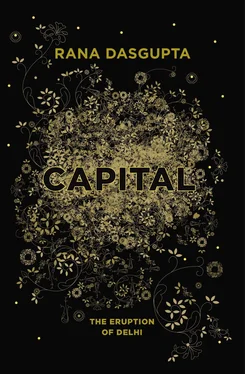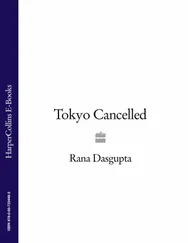Outside, blasted trees stick up like burnt matches from the rubble.
I pass under one of the blistered flyovers across which Delhi’s orbital roads soar and dip like a rollercoaster. These scattered megaliths do not feel as if they constitute a system: each of them proclaims different traffic principles, and looks quite unlike the next. Several different construction firms have built them; each has used a different design, a different kind of brick and a different variety of street light, and each has finished things off with its own kind of ornamental flourish. Driving from one to the next is to find the road broadening and narrowing arbitrarily, which creates the crawl-surge rhythm that is so much a part of movement in this city. Two flyovers end in the same place, as if they were not informed about each other, thus feeding fast-moving traffic into a criss-cross swamp of cars from which it takes twenty minutes to emerge.
Like so much of the rest of the city’s infrastructure, these gap-toothed flyovers look ancient even when they have only just been built. Delhi’s recent multibillion-dollar makeover, completed just in time for the 201 °Commonwealth Games, is already difficult to remember: down the centre of main roads, great sections of the new dividing walls have broken off and fallen into the path of traffic, while the roofs are falling off the rusty Games stadiums, whose car parks lie cracked and empty. The thousands of trees planted to soften the edges of so much new concrete are long since withered, as if they were never intended to outlast the Games themselves. Time in Delhi is macabre: it is a fast-dissolving time that makes bus stops leak and apartment blocks crumble even before they are finished. A time that sinks potholes in month-old roads, built only just well enough to hold together for their inauguration. A time that instantly makes superfluous the avenues recently slashed through slums because the state-of-the-art sports facilities they led to have been padlocked and left to collapse. To be here is to exist in that kind of time in which everything is old even when it is new, in which everything is always already lost to decay and obsolescence.
Nothing endures: everything is passing away before one’s eyes, and it is difficult to preserve the soul from the general tendency. Perhaps one can see why the pristine maintenance of Rakesh’s private compound was so arresting. In the Delhi context, its force was almost existential, as if, with every piece of gravel his gardeners swept back into place, Rakesh attempted to immunise himself against the general impermanence.
• • •
I turn through the heart of British Delhi, still preserved as the city’s administrative centre and therefore largely unaffected by the tearing-down and rebuilding that has taken over the rest of the city. The tree canopy is luxurious overhead and the traffic flows freely. I pass two elephants lumbering steadily along the road. Here and there they pause to pull down branches from the trees, which they chew on meditatively as they trudge home from their labours. Car headlights shine at the level of their knees and only their bandy-legs are illuminated: the great dome of their backs, where the sleepy rider sits, rises above it all, into the darkness.
The sight of these animals always fills me with a rush of love for Delhi. Even in the megapolis, they are still improbably vast — vast enough to be a kind of sink for the city’s strife, removing, like a rainforest, the poisons from its air.
Just beyond the elephants lumbers something else: a massive water tanker. Large sections of Delhi, and not only the poor ones, have no piped water and must fill their household tanks, expensively and laboriously, from trucks like these. I have never seen one that is not leaking at a catastrophic rate. It seems to be part of the cold humour of this city, where water is so precious that the Water Board that controls it pours half of it away on the dusty roads.
Rusty and battered, this particular truck has the regulation deluge escaping from several places on its underside. For added comic effect the operators have also left the cap off the filling hole above, so that a great wave pours out every time it brakes.
It stops now at some traffic lights, and I stop with it.
The traffic lights are shining constant red and flashing amber together. At other times I have seen constant amber with flashing green, red and green together, or flashing amber in all directions. It would be possible to see this expanded traffic light vocabulary as festive, except that it arises from impotence and gloom — from the authorities’ inability to stop nocturnal drivers shooting through intersections like this at high speed, whatever the colour of the lights, killing themselves and others. Traditional red lights were too static, too passé perhaps, to arrest the contemporary rush of life, money and drink. So it was decided to introduce something more spirited and fresh. Lights flashing in different colours might just stimulate people — if not into stopping, at least into a moment of hesitation.
In other cases, the waning power of the light symbols is propped up with text annotations: “Do not move on red light. Proceed only on green light.”
Piled up on the pavements are the rusty corpses of the last generation of traffic lights.
A man with severed arms begs at the windows of stationary cars; he cannot take the money, obviously, but proffers his trouser pocket to anyone feeling generous. I wonder how a man with no arms eats. I wonder how he unbuttons his trousers.
The intersection is enormous and pummelled by neon light. The roads are divided by raised triangular islands which are covered with sleeping people. A large air-conditioned bus crosses in front of me, full of retired European tourists reading guide books — or sleeping, too.
All around the intersection are large advertising hoardings. One is for a new corporate housing development called Cape Town. It shows computer-generated images of sunny apartments, well-parked BMWs, cute flower beds and rich, happy, light-skinned people laughing around the swimming pool. Ten years ago such a development would have been named after an American locale. Delhi’s consumers have become more worldly in that time, however, and they realise that the American suburb is too democratic and open for their tastes. For glamour they turn now to South Africa, Russia or Dubai, where things are more in control.
Another advertisement is for a shopping mall. It shows a man bursting with consumer glee because he has so many different kinds of outfit to try on. The slogan says, “Change Keeps Boring Away.” It takes me a moment to realise what these words mean. Having just driven forty minutes through a much-punctured city, I am led immediately to thoughts of drills. Of the enormous perforations that have opened up in Delhi’s consciousness during this period of transition. But then I realise that the advertisement is talking, neologistically, about boredom . In this churning metropolis of instant millionaires and imperial ambition, where people who fifteen years ago had not seen a microwave now drive Lamborghinis — the biggest threat, apparently, is ennui.
Next to the advertising hoardings is a big garbage heap. Pigs nuzzle among plastic bags and rotting food. I scan the scruffy sign above it, which says, “There Are No Bars To Excrement.” Surprised, I look at it again. This time it says, “There Are No Bars To Excellence.”
I must be tired.
The lights change. The water tanker heaves, and another tide washes over its back, drenching the road. I turn under another cavernous flyover where lines of washing hang, adults sleep and children play with sticks. I am on the last stretch before home.
Suddenly the cars around me are braking and swerving. In front of me, the traffic parts, and I see, standing in my path, a young man dressed in rags. I slow down, expecting him to get out of the way. But he stands his ground, stares at me haughtily and holds up his palm so I halt. My car stops a few inches from where he is standing. For a few moments we stare into each other’s eyes. He is about sixteen and his hair is wild. Around his neck he wears a great number of tinsel garlands adorned with images of elemental divine power. Kali, Durga and Shiva. There are so many of them that the bundle of tinsel around his neck rises over his ears and covers half his face.
Читать дальше











